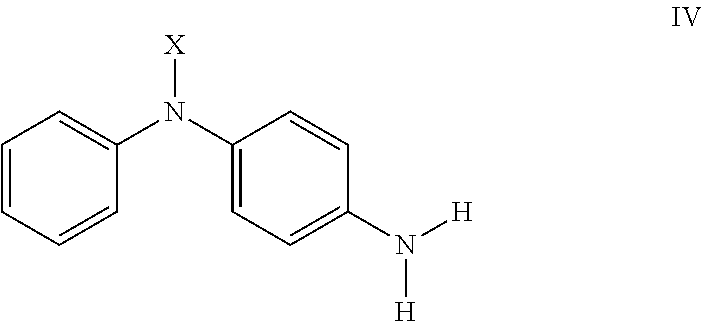Methods of making compounds and mixtures having antidegradant and antifatigue efficacy
a technology of anti-fatigue and compound, applied in the field of making compounds and mixtures with anti-degradant and anti-fatigue efficacy, can solve the problems of difficult to achieve, many materials such as plastics, elastomers, oils, etc., and are prone to degradation
- Summary
- Abstract
- Description
- Claims
- Application Information
AI Technical Summary
Benefits of technology
Problems solved by technology
Method used
Image
Examples
example 1
Preparation of Precursor (N,N′,N,N′)-N,N′-(ethane-1,2-diylidene)bis(N-phenylbenzene-1,4-diamine)
[0071]
[0072]In a 3-neck 1 L round-bottom flask with overhead stirrer, 4-ADPA (127 g, 689 mmol) was dissolved in EtOH (200 proof, 363 mL). In a separate beaker, glyoxal (40% in water, 50 g, 345 mmol) was added to a mixture of EtOH:water (1:1,100 mL). The glyoxal solution was then added drop wise to the reaction mixture over a 50 minute period—a red solid began to form during the addition. The mixture was stirred for an additional 20 minutes, after which water (150 mL) was added all at once to further precipite the dark red solid. The slurry was stirred overnight. After recovering the solid by filtration and washing with additional water, the red solid was placed in a 50° C. vacuum oven (with nitrogen sweep) overnight (131.57 g, 98% yield). 1H NMR (300 MHz, DMSO-d6) δ 8.49 (bs, 2H), 8.47 (s, 2H), 7.38 (m, 4H), 7.31-7.28 (m, 4H), 7.16-7.11 (m, 8H), 6.92-6.89 (m, 2H).
example 2
Preparation of N,N′-(ethane-1,2-diyl)bis(N-phenylbenzene-1,4-diamine)
[0073]
[0074]DIBAL-H (122 g, 25 wt. % in toluene) was slowly cannulated into a 1 L round-bottom flask that contained THF (102 mL). Then the di-imine 1 (20.0 g, 50.2 mmol) was carefully added at ambient temperature. After the addition was complete, the mixture was heated to 60° C. and allowed to react for 19.25 hours. Then the reaction was cooled using an ice-water bath to ca. 5-10° C., at which point a saturated solution of NaK tartrate was added drop wise until the reaction mixture formed a gel. At that point, 250 mL of the NaK tartrate solution was quickly added, followed by 500 mL of EtOAc. The biphasic mixture was vigorously stirred overnight. The mixture was then transferred to a 1-L separatory funnel, and the layers were then separated. The organics were dried with Na2SO4. The mixture was then filtered through a short plug of silica gel, and the cake was rinsed with a small amount of EtOAc and THF. The product...
example 3
Alternative Preparation of N,N′-(ethane-1,2-diyl)bis(N-phenylbenzene-1,4-diamine)
[0075]
[0076]Procedure: 20 g of water-wet Raney Ni slurry was transferred to a Parr bottle. Then 400 g of dimethylformamide (DMF) and 200 g of EtOH were added. 200 g of bis-imine 1 was added to the catalyst / solvent mixture. The bottle was placed in a Parr shaker apparatus and was purged with nitrogen three times. The vessel was purged with H2 gas three times and then pressurized to 40 psig. Agitation was initiated, and the contents were heated to an internal set point of 48° C. Once the reaction was at temperature, the H2 pressure was adjusted to 50 psig. The reaction was agitated for 2.5 hrs, and then allowed to cool to ambient temp over 1 hr. The catalyst was clarified by passing the mixture through a plug of celite, using a minimal amount of DMF / EtOH (110 g DMF, 140 g of EtOH) to rinse the bottle and cake. The homogeneous mixture was transferred to a 1 L round-bottom flask with magnetic stir bar. 750 ...
PUM
| Property | Measurement | Unit |
|---|---|---|
| temperature | aaaaa | aaaaa |
| time | aaaaa | aaaaa |
| time | aaaaa | aaaaa |
Abstract
Description
Claims
Application Information
 Login to View More
Login to View More - R&D
- Intellectual Property
- Life Sciences
- Materials
- Tech Scout
- Unparalleled Data Quality
- Higher Quality Content
- 60% Fewer Hallucinations
Browse by: Latest US Patents, China's latest patents, Technical Efficacy Thesaurus, Application Domain, Technology Topic, Popular Technical Reports.
© 2025 PatSnap. All rights reserved.Legal|Privacy policy|Modern Slavery Act Transparency Statement|Sitemap|About US| Contact US: help@patsnap.com



